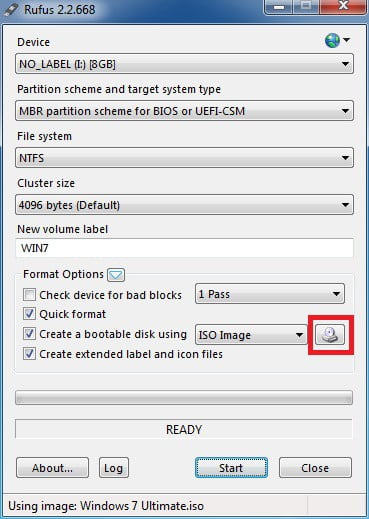
- CREATE A BOOTABLE USB DRIVE WINDOWS 7 ISO SOFTWARE
- CREATE A BOOTABLE USB DRIVE WINDOWS 7 ISO ISO
- CREATE A BOOTABLE USB DRIVE WINDOWS 7 ISO WINDOWS 7
- CREATE A BOOTABLE USB DRIVE WINDOWS 7 ISO DOWNLOAD
CREATE A BOOTABLE USB DRIVE WINDOWS 7 ISO WINDOWS 7
When all is said and done, reboot your computer with the thumb drive in place and you should be greeted with the Windows 7 installation menu. It’ll take maybe about ten minutes for everything to copy over. That is, don’t drag the gobbledygook folder over open it up first and drag the stuff inside of it over instead. You should be copying five folders and three files to the thumb drive. This is it! The final step! Open up your extracted Windows 7 gobbledygook folder and copy the files over to your thumb drive. Step Seven: Copy the Windows 7 files to the thumb drive This just means that the thumb drive is now ripe to auto-load when you boot up your computer. Hit enter and you should see:īlah, blah, blah your bootcode is something something. We’re assuming the drive letter of your USB thumb drive is F:, so replace “f:” in the above phrase with whichever letter is assigned to your particular thumb drive. At this point, we’ll type the following (without the quotes): We should then have a straight-up C:> prompt.
CREATE A BOOTABLE USB DRIVE WINDOWS 7 ISO ISO
Once we’ve got the Command Prompt up, we’re going to switch to our top-level C: folder by simply typing “cd\” without the quotes and hitting Enter (If you skipped Step Five above, then navigate yourself to the “boot” folder inside the extracted ISO folder on your desktop). So go into Programs > Accessories and then right-click on Command Prompt and choose “Run as administrator.” If you’re using Vista or Windows 7, you’ll have to do the “Run as administrator” thing or we won’t be able to deploy our sweet flanking maneuvers that are coming up. Now we’re going to open the Command Prompt. Step Six: Do some Ninja-like stuff in DOS See it there? Fifth file from the bottom, all safe and sound? We’re going to paste (CTRL-V) that “bootsect.exe” file right into C: so we can easily access it in a moment. Copy the file (CTRL-C) and then open up “Computer” or “My Computer” and double-click your C: drive. If you don’t like DOS or haven’t used it much, we’re going to copy this bootsect.exe file into an easy-to-access location. If you’re comfortable navigating folders in DOS, then you can skip this particular step. Now we’re going to go back to our extracted “7012-1400_client_en-us_Ultimate-GB1CULFRE_EN_DVD” gobbledygook folder and open the “boot” folder, inside which we’ll find a file called “bootsect.exe” that we’ll need to use. You can check the Quick Format box, too, if it’s not already checked. Right click on the drive and choose “Format…” Then, we want to format the drive using the NTFS file system with the default allocation size, so make sure those two things are selected from the dropdown menus. In this instance, we’re dealing with the F: drive. Head into “Computer” or “My Computer” and locate your USB thumb drive. I’ll continue to refer to this folder as “the gobbledygook folder” for the rest of this guide. When the smoke has cleared, you’ll have a gobbledygook folder on your desktop. Right-click on that file and choose “Extract to ” as shown in the above picture. Once Windows 7 Beta has finished downloading, you should see a file on your desktop with a bunch of gobbledygook in the name like “7012-1400_client_en-us_Ultimate-GB1CULFRE_EN_DVD” or something cryptic like that. Step Three: Extract the Windows 7 ISO file
CREATE A BOOTABLE USB DRIVE WINDOWS 7 ISO DOWNLOAD
Head over to and click on the WinRAR 3.80 link to download the software.
CREATE A BOOTABLE USB DRIVE WINDOWS 7 ISO SOFTWARE
I promise this will be the only third-party software that you’ll have to download and install, though, and it’s a great program to have on your computer anyway if you don’t already. I hate guides that make me go download a bunch of software just to accomplish a task, so I apologize for making you do the same thing. The download might take a while depending on your connection speed – set aside an hour to be on the safe side. For the sake of this exercise, we’ll assume that you’ll download the ISO file to your desktop. Head over to and jump through all the hoops to begin your download. It’s all pretty easy once you get going, so let’s begin.

I found a SanDisk Cruzer Contour worked best, while a Kingston DataTraveler was a bit fidgety at first but worked after a couple of tries. The only tangible thing you’ll need is a USB thumb drive with at least 4GB of capacity. There are plenty of great tutorials out there that basically contain the same information as this one, but I thought I’d try to put together a how-to guide that made everything as simple as possible for people who might like the idea of Windows on a thumb drive but aren’t necessarily super comfortable with the actual process. Creating a bootable USB thumb drive with Windows 7 loaded onto it is more complicated than it needs to be, but once it’s done it’s a great tool to have. Half of my computers don’t have optical drives and I don’t want to buy an external one.ģ.

I hate waiting for DVDs to burn ISO images.Ģ. I’ve been playing with Windows 7 Beta for a the past week or so and after loading it up on multiple machines I’ve learned a few things:ġ.


 0 kommentar(er)
0 kommentar(er)
